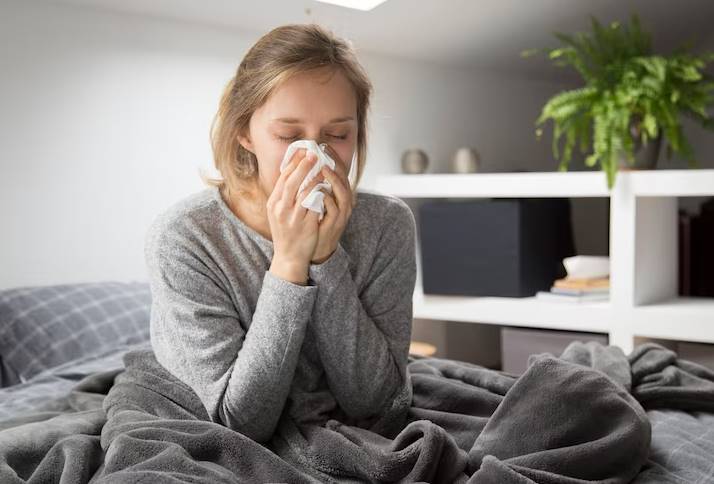Flying has become an integral part of our lives, and we often take it for granted. With air travel, however, comes the risk of contracting a common cold, which can ruin your vacation or business trip. Airplanes, like public transport, are notorious for harboring a host of germs and viruses from other passengers.
The low humidity levels and dry air in the cabin can make it easier for the virus to spread, resulting in a host of cold symptoms post-flight. In this article, we’ll discuss how to handle the symptoms of a cold after flying so that you can get back on track quickly.
Causes of Cold Symptoms After Flying
Airplane cabins are notorious for harboring germs from various sources, including recycled air, tray tables, armrests, and air vents. The close proximity of fellow passengers makes it easy for germs to spread from person to person. The low humidity levels in the cabin also dry out your nasal passages and throat, making it easier for germs to take hold.

Common Cold Symptoms After Flying
The symptoms of a cold after flying are similar to those you would experience on the ground. However, they may be more intense and severe due to the conditions of the airplane cabin. Some of the most common cold symptoms experienced after a flight include:
- Sore throat
- Runny or stuffy nose
- Headache
- Coughing
- Fatigue
- Body aches
- Fever
Tips for Preventing Cold Symptoms After Flying
Prevention is crucial when it comes to avoiding cold symptoms after flying. Here are some tips to help you avoid catching a cold on your next flight:
1. Use Hand Sanitizer Frequently: Carry a travel-sized hand sanitizer with you and use it every time you come into contact with germs, such as touching the armrest, tray table, or someone else’s belongings.
2. Wear a Face Mask: A face mask can help protect you from germs, especially during cold and flu season.
3. Drink Plenty of Water: Keeping your body hydrated is key to preventing cold symptoms. Drinking plenty of water before, during, and after the flight can help keep your nasal passages and throat moist.
4. Clean your Surroundings: Use antibacterial wipes to clean your surroundings, such as the tray table, armrest, and seat belt, before settling into your seat.
5. Choose a Window Seat: Sitting in a window seat can reduce your exposure to other passengers and their germs.
Home Remedies for Cold Symptoms After Flying
If you do catch a cold after flying, don’t fret. There are several home remedies you can try to alleviate your symptoms, including:
1. Drink Warm Liquids: Hot liquids, such as tea, broth, or hot water with lemon and honey, can help soothe your throat and relieve congestion.
2. Use Nasal Saline Spray: Nasal saline spray can help moisturize your nasal passages and relieve congestion.
3. Get Plenty of Rest: Rest is essential when battling a cold. Aim for at least 7-8 hours of sleep each night.
4. Use a Humidifier: Using a humidifier in your hotel room can help keep your nasal passages moist, making it easier to breathe.
5. Take Over-the-Counter Medications: Over-the-counter medications, such as pain relievers, decongestants, and cough suppressants, can help alleviate your cold symptoms.
Conclusion
In conclusion, cold symptoms after flying can be inconvenient and downright miserable, but they don’t have to ruin your travels. By following the tips mentioned above and taking care of yourself, you can reduce your risk of catching a cold and alleviate your symptoms if you do get one. Remember to stay hydrated, clean your surroundings, and get plenty of rest to keep your immune system strong. By incorporating these practices into your travel routine, you’ll be able to enjoy your travels to the fullest while staying healthy and happy.
FAQs – Cold Symptoms After Flying
1. Why do some people experience cold symptoms after flying?
Cold symptoms after flying can be caused by a variety of factors such as exposure to germs in the airplane cabin, changes in air pressure, and dehydration due to low humidity levels. Additionally, stress and fatigue from traveling can weaken the immune system, making it more susceptible to catching a cold.
2. How long do cold symptoms usually last after flying?
Cold symptoms after flying typically last for 7-10 days, similar to the duration of a common cold. However, the severity and duration of symptoms may vary depending on factors such as the individual’s immune system and overall health.
3. Are there any ways to prevent cold symptoms after flying?
To minimize the risk of developing cold symptoms after flying, maintain good hygiene by washing your hands frequently, avoid touching your face, and use hand sanitizer when necessary. Stay hydrated throughout the flight, get enough rest before and after traveling, and consider using a saline nasal spray to keep your nasal passage moist.
4. Can wearing a mask help prevent cold symptoms after flying?
Wearing a mask during a flight can help reduce the spread of germs and may lower the risk of contracting a cold. Masks are most effective when combined with other preventative measures such as handwashing and maintaining good overall health.
5. Is it normal to develop a fever after flying?
While it is not common to develop a fever specifically due to flying, it could be an indication that you have contracted a cold or another illness during your travels. If you experience a fever along with other cold symptoms, it is recommended to consult a healthcare professional for proper evaluation and treatment.
6. What over-the-counter medications can help alleviate cold symptoms after flying?
Over-the-counter medications such as decongestants, antihistamines, and pain relievers can help alleviate cold symptoms after flying. However, it is essential to consult with a healthcare professional or pharmacist before taking any medication to ensure it is appropriate for your specific symptoms and health condition.
7. How can I tell if my cold symptoms are due to flying or an actual cold?
It may be difficult to determine whether your cold symptoms are specifically due to flying or an actual cold. If your symptoms persist or worsen after a few days, it is more likely that you have contracted a cold or another illness. Consult a healthcare professional for proper evaluation and treatment.
8. Can flying with a cold cause complications or worsen symptoms?
Flying with a cold can lead to complications such as sinus pain, earaches, and increased congestion due to changes in air pressure during the flight. To minimize discomfort, take steps to alleviate your symptoms before flying, such as using a decongestant or saline nasal spray, and consult with a healthcare professional if necessary.


















